Hotel Property Investments (HPI) Financial Analysis Report
VerifiedAdded on 2022/10/18
|12
|2170
|7
Report
AI Summary
This report provides a comprehensive financial analysis of Hotel Property Investments (HPI) for the years 2015-2018. It begins with an executive summary outlining the key findings regarding HPI's profitability, liquidity, and overall financial performance. The report includes a company overview, followed by detailed analyses. Trend analysis reveals the movement of total revenue and net profit over the four-year period, identifying upward trends in revenue and a decline in profits in the most recent year. Vertical analysis examines the proportion of various financial statement items, while ratio analysis assesses profitability and liquidity using relevant financial ratios. The profitability ratios reveal a decline in returns, while liquidity ratios indicate a need for improvement. The report concludes with a summary of the key findings and includes references and appendices with supporting financial data.
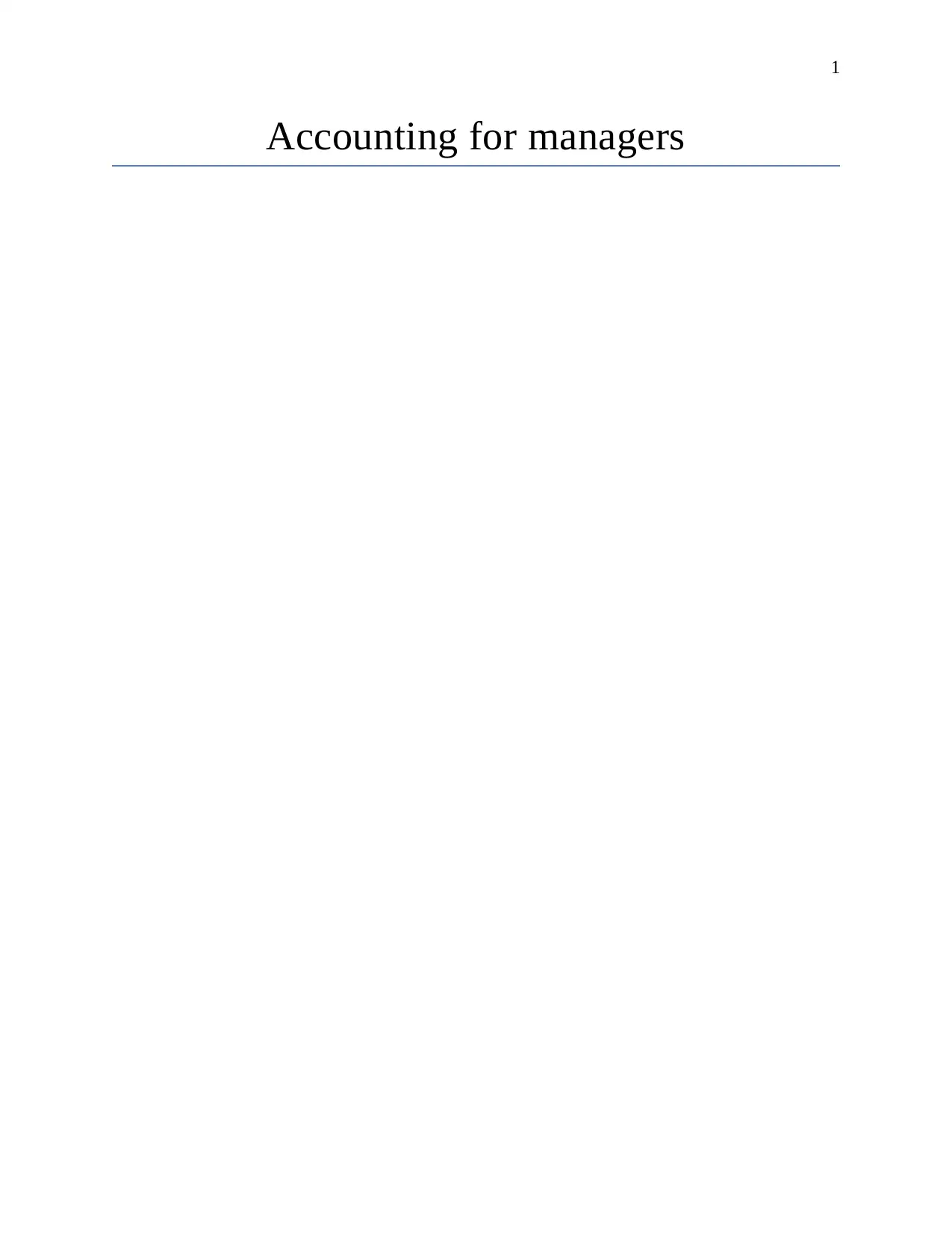
1
Accounting for managers
Accounting for managers
Paraphrase This Document
Need a fresh take? Get an instant paraphrase of this document with our AI Paraphraser
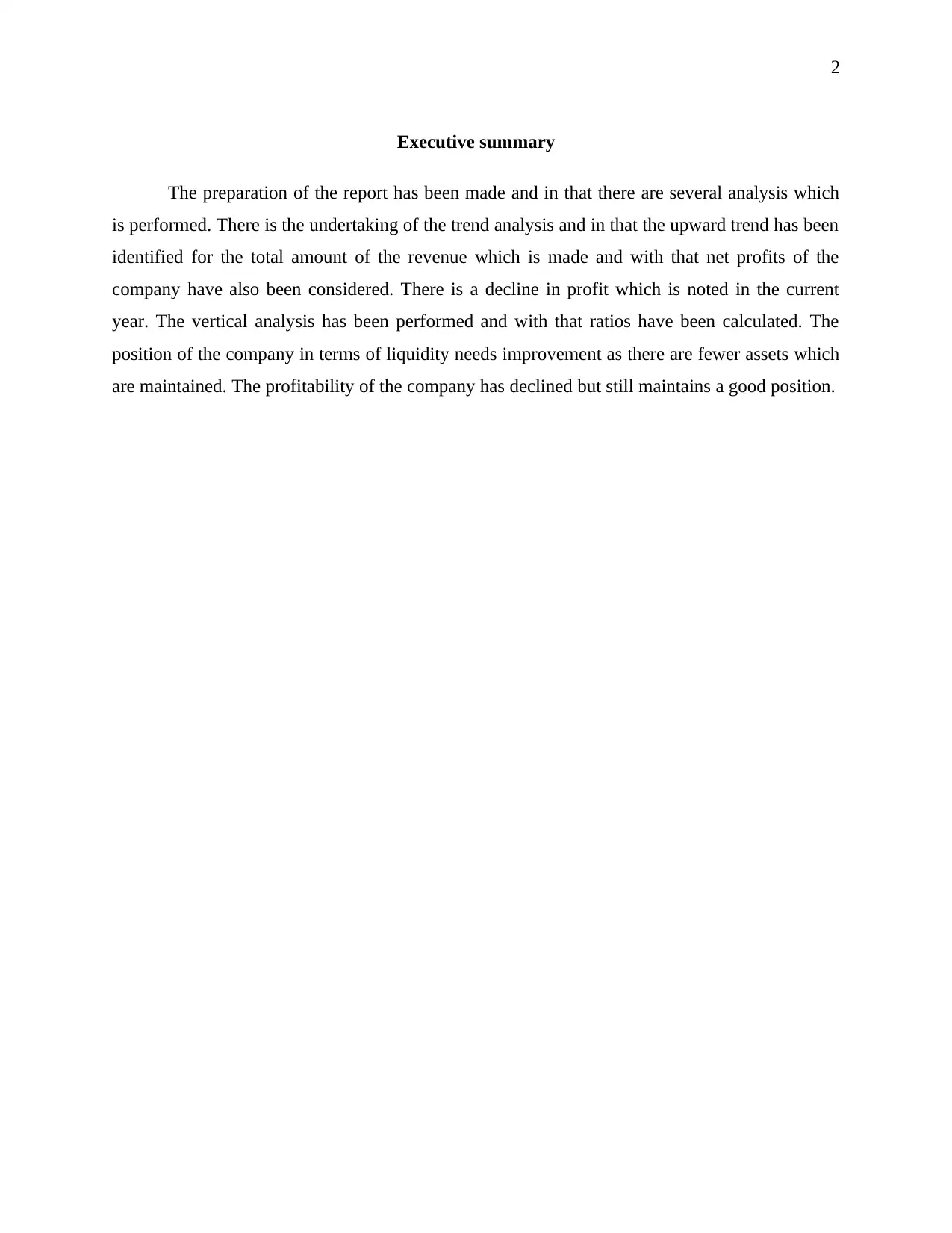
2
Executive summary
The preparation of the report has been made and in that there are several analysis which
is performed. There is the undertaking of the trend analysis and in that the upward trend has been
identified for the total amount of the revenue which is made and with that net profits of the
company have also been considered. There is a decline in profit which is noted in the current
year. The vertical analysis has been performed and with that ratios have been calculated. The
position of the company in terms of liquidity needs improvement as there are fewer assets which
are maintained. The profitability of the company has declined but still maintains a good position.
Executive summary
The preparation of the report has been made and in that there are several analysis which
is performed. There is the undertaking of the trend analysis and in that the upward trend has been
identified for the total amount of the revenue which is made and with that net profits of the
company have also been considered. There is a decline in profit which is noted in the current
year. The vertical analysis has been performed and with that ratios have been calculated. The
position of the company in terms of liquidity needs improvement as there are fewer assets which
are maintained. The profitability of the company has declined but still maintains a good position.

3
Table of Contents
Executive summary.........................................................................................................................2
Introduction......................................................................................................................................4
Company overview..........................................................................................................................4
Analysis...........................................................................................................................................4
Trend analysis..............................................................................................................................4
Vertical analysis...........................................................................................................................6
Ratio analysis...............................................................................................................................6
Conclusion.......................................................................................................................................8
References........................................................................................................................................9
Appendix........................................................................................................................................10
Table of Contents
Executive summary.........................................................................................................................2
Introduction......................................................................................................................................4
Company overview..........................................................................................................................4
Analysis...........................................................................................................................................4
Trend analysis..............................................................................................................................4
Vertical analysis...........................................................................................................................6
Ratio analysis...............................................................................................................................6
Conclusion.......................................................................................................................................8
References........................................................................................................................................9
Appendix........................................................................................................................................10
⊘ This is a preview!⊘
Do you want full access?
Subscribe today to unlock all pages.

Trusted by 1+ million students worldwide

4
Introduction
Accounting is required to be made in the most adequate manner and in that various
aspects shall be taken into account. There will be consideration of all in this report for the hotel
property investments. The overview of the company will be obtained and in that complete
information about the company will be collected. The trend analysis will be performed where the
change in the total revenue and net profit of the company will be taken into account. The vertical
analysis will be performed and with that, the ratio analysis will be undertaken to identify the
changes in the liquidity and profitability of the business.
Company overview
HPI is an Australian company which is involved in pub and lessor activities. Investment
in real estate is the main business of the company. There is the portfolio of the company in which
the freehold properties are involved in relation to the pubs (HPI, 2019). The leasing of the pubs
is undertaken and they are provided to the Australian leisure and hospitality and Coles group.
They are mainly operating the South Australia and Queensland.
Analysis
Trend analysis
In the business, there are various changes which take place with time and it is required
that they shall be identified and analyzed in an effective manner. For this trend analysis is
performed which records the trend that is involved in the business (Williams & Dobelman,
2017). All of the changes and their direction of movement are determined with the help of this.
The same is performed for the company is as follows.
Particulars 2015 2016 2017 2018
Total revenue 45030 47872 48727 50253
Net profit 35435 60128 98899 48387
Introduction
Accounting is required to be made in the most adequate manner and in that various
aspects shall be taken into account. There will be consideration of all in this report for the hotel
property investments. The overview of the company will be obtained and in that complete
information about the company will be collected. The trend analysis will be performed where the
change in the total revenue and net profit of the company will be taken into account. The vertical
analysis will be performed and with that, the ratio analysis will be undertaken to identify the
changes in the liquidity and profitability of the business.
Company overview
HPI is an Australian company which is involved in pub and lessor activities. Investment
in real estate is the main business of the company. There is the portfolio of the company in which
the freehold properties are involved in relation to the pubs (HPI, 2019). The leasing of the pubs
is undertaken and they are provided to the Australian leisure and hospitality and Coles group.
They are mainly operating the South Australia and Queensland.
Analysis
Trend analysis
In the business, there are various changes which take place with time and it is required
that they shall be identified and analyzed in an effective manner. For this trend analysis is
performed which records the trend that is involved in the business (Williams & Dobelman,
2017). All of the changes and their direction of movement are determined with the help of this.
The same is performed for the company is as follows.
Particulars 2015 2016 2017 2018
Total revenue 45030 47872 48727 50253
Net profit 35435 60128 98899 48387
Paraphrase This Document
Need a fresh take? Get an instant paraphrase of this document with our AI Paraphraser
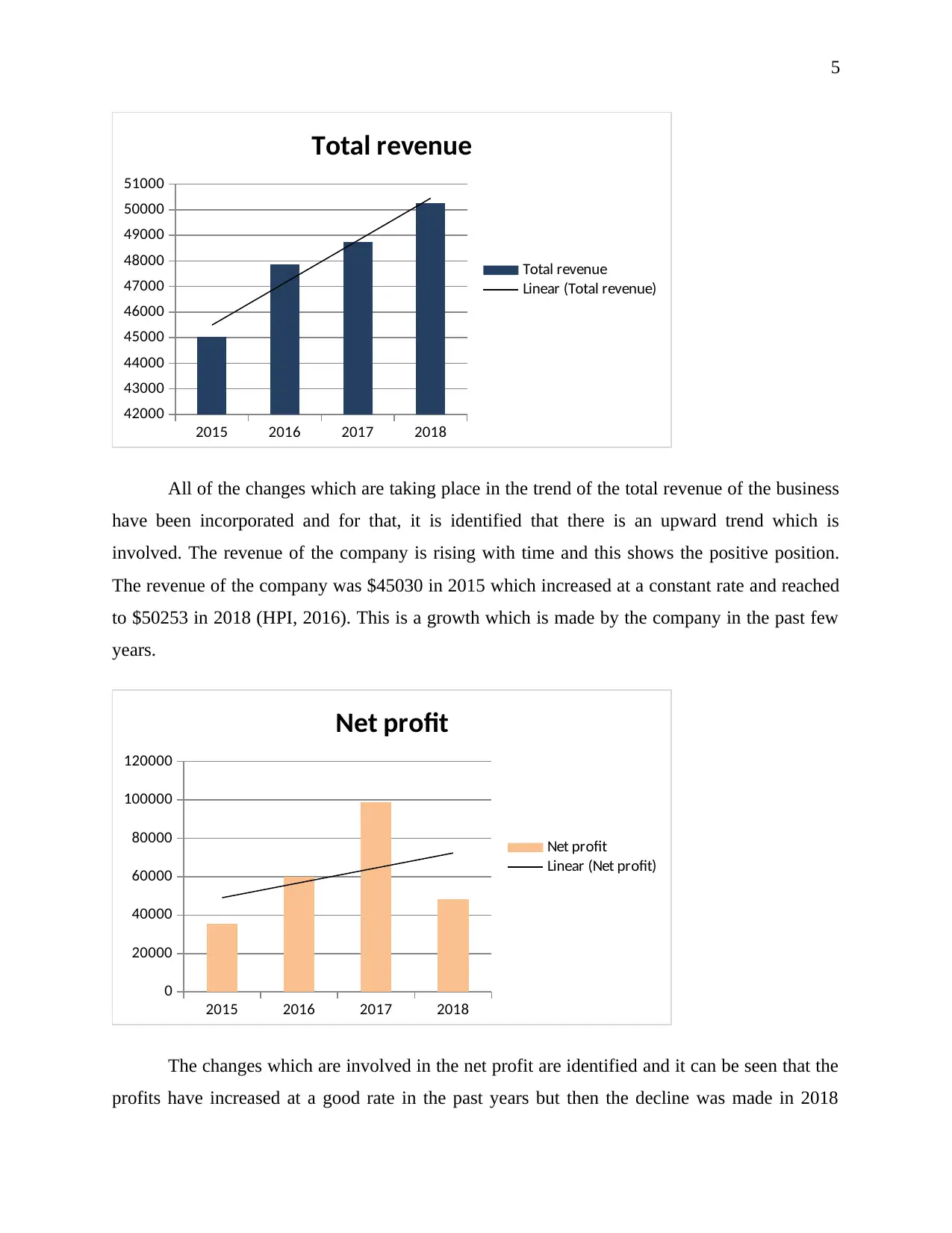
5
2015 2016 2017 2018
42000
43000
44000
45000
46000
47000
48000
49000
50000
51000
Total revenue
Total revenue
Linear (Total revenue)
All of the changes which are taking place in the trend of the total revenue of the business
have been incorporated and for that, it is identified that there is an upward trend which is
involved. The revenue of the company is rising with time and this shows the positive position.
The revenue of the company was $45030 in 2015 which increased at a constant rate and reached
to $50253 in 2018 (HPI, 2016). This is a growth which is made by the company in the past few
years.
2015 2016 2017 2018
0
20000
40000
60000
80000
100000
120000
Net profit
Net profit
Linear (Net profit)
The changes which are involved in the net profit are identified and it can be seen that the
profits have increased at a good rate in the past years but then the decline was made in 2018
2015 2016 2017 2018
42000
43000
44000
45000
46000
47000
48000
49000
50000
51000
Total revenue
Total revenue
Linear (Total revenue)
All of the changes which are taking place in the trend of the total revenue of the business
have been incorporated and for that, it is identified that there is an upward trend which is
involved. The revenue of the company is rising with time and this shows the positive position.
The revenue of the company was $45030 in 2015 which increased at a constant rate and reached
to $50253 in 2018 (HPI, 2016). This is a growth which is made by the company in the past few
years.
2015 2016 2017 2018
0
20000
40000
60000
80000
100000
120000
Net profit
Net profit
Linear (Net profit)
The changes which are involved in the net profit are identified and it can be seen that the
profits have increased at a good rate in the past years but then the decline was made in 2018
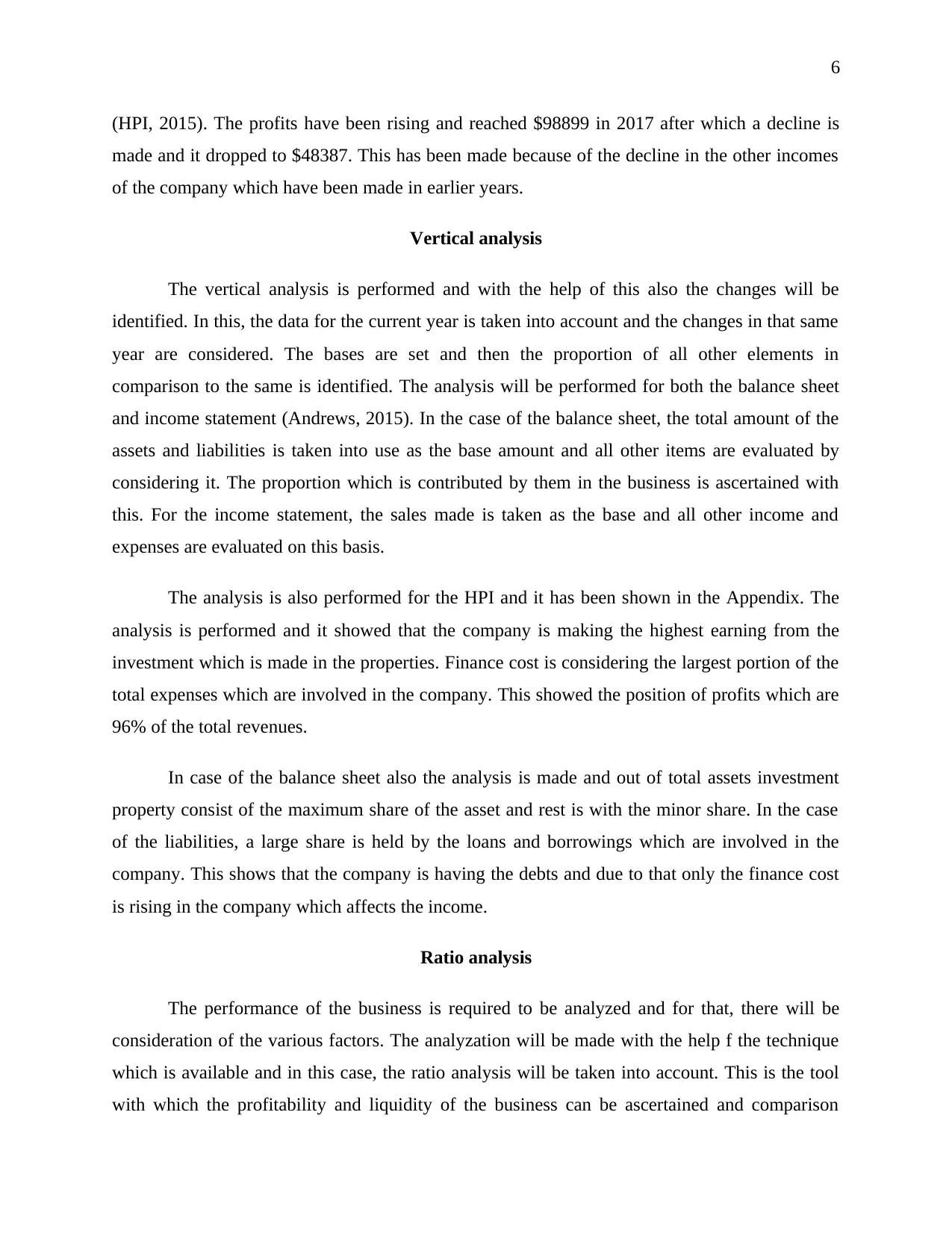
6
(HPI, 2015). The profits have been rising and reached $98899 in 2017 after which a decline is
made and it dropped to $48387. This has been made because of the decline in the other incomes
of the company which have been made in earlier years.
Vertical analysis
The vertical analysis is performed and with the help of this also the changes will be
identified. In this, the data for the current year is taken into account and the changes in that same
year are considered. The bases are set and then the proportion of all other elements in
comparison to the same is identified. The analysis will be performed for both the balance sheet
and income statement (Andrews, 2015). In the case of the balance sheet, the total amount of the
assets and liabilities is taken into use as the base amount and all other items are evaluated by
considering it. The proportion which is contributed by them in the business is ascertained with
this. For the income statement, the sales made is taken as the base and all other income and
expenses are evaluated on this basis.
The analysis is also performed for the HPI and it has been shown in the Appendix. The
analysis is performed and it showed that the company is making the highest earning from the
investment which is made in the properties. Finance cost is considering the largest portion of the
total expenses which are involved in the company. This showed the position of profits which are
96% of the total revenues.
In case of the balance sheet also the analysis is made and out of total assets investment
property consist of the maximum share of the asset and rest is with the minor share. In the case
of the liabilities, a large share is held by the loans and borrowings which are involved in the
company. This shows that the company is having the debts and due to that only the finance cost
is rising in the company which affects the income.
Ratio analysis
The performance of the business is required to be analyzed and for that, there will be
consideration of the various factors. The analyzation will be made with the help f the technique
which is available and in this case, the ratio analysis will be taken into account. This is the tool
with which the profitability and liquidity of the business can be ascertained and comparison
(HPI, 2015). The profits have been rising and reached $98899 in 2017 after which a decline is
made and it dropped to $48387. This has been made because of the decline in the other incomes
of the company which have been made in earlier years.
Vertical analysis
The vertical analysis is performed and with the help of this also the changes will be
identified. In this, the data for the current year is taken into account and the changes in that same
year are considered. The bases are set and then the proportion of all other elements in
comparison to the same is identified. The analysis will be performed for both the balance sheet
and income statement (Andrews, 2015). In the case of the balance sheet, the total amount of the
assets and liabilities is taken into use as the base amount and all other items are evaluated by
considering it. The proportion which is contributed by them in the business is ascertained with
this. For the income statement, the sales made is taken as the base and all other income and
expenses are evaluated on this basis.
The analysis is also performed for the HPI and it has been shown in the Appendix. The
analysis is performed and it showed that the company is making the highest earning from the
investment which is made in the properties. Finance cost is considering the largest portion of the
total expenses which are involved in the company. This showed the position of profits which are
96% of the total revenues.
In case of the balance sheet also the analysis is made and out of total assets investment
property consist of the maximum share of the asset and rest is with the minor share. In the case
of the liabilities, a large share is held by the loans and borrowings which are involved in the
company. This shows that the company is having the debts and due to that only the finance cost
is rising in the company which affects the income.
Ratio analysis
The performance of the business is required to be analyzed and for that, there will be
consideration of the various factors. The analyzation will be made with the help f the technique
which is available and in this case, the ratio analysis will be taken into account. This is the tool
with which the profitability and liquidity of the business can be ascertained and comparison
⊘ This is a preview!⊘
Do you want full access?
Subscribe today to unlock all pages.

Trusted by 1+ million students worldwide
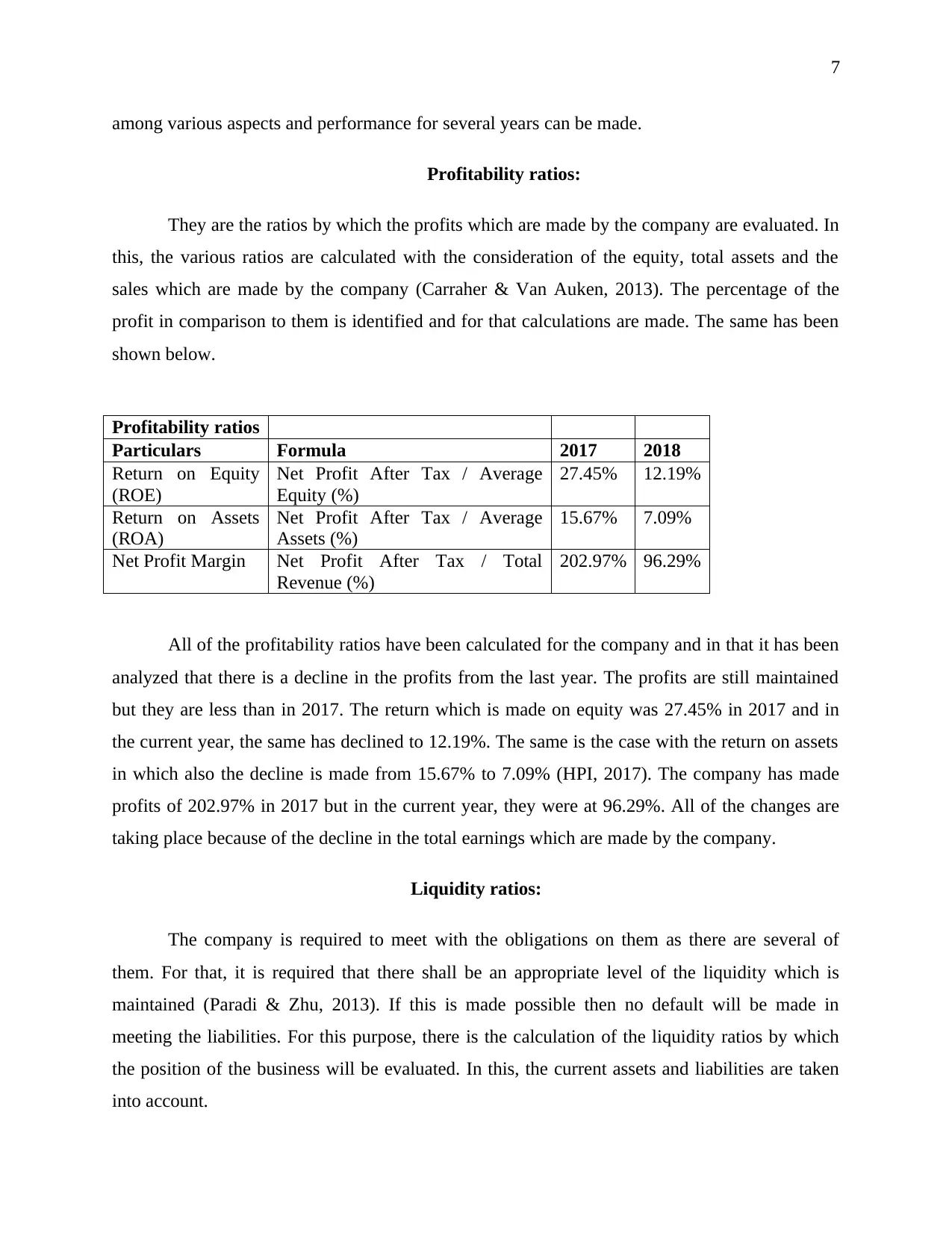
7
among various aspects and performance for several years can be made.
Profitability ratios:
They are the ratios by which the profits which are made by the company are evaluated. In
this, the various ratios are calculated with the consideration of the equity, total assets and the
sales which are made by the company (Carraher & Van Auken, 2013). The percentage of the
profit in comparison to them is identified and for that calculations are made. The same has been
shown below.
Profitability ratios
Particulars Formula 2017 2018
Return on Equity
(ROE)
Net Profit After Tax / Average
Equity (%)
27.45% 12.19%
Return on Assets
(ROA)
Net Profit After Tax / Average
Assets (%)
15.67% 7.09%
Net Profit Margin Net Profit After Tax / Total
Revenue (%)
202.97% 96.29%
All of the profitability ratios have been calculated for the company and in that it has been
analyzed that there is a decline in the profits from the last year. The profits are still maintained
but they are less than in 2017. The return which is made on equity was 27.45% in 2017 and in
the current year, the same has declined to 12.19%. The same is the case with the return on assets
in which also the decline is made from 15.67% to 7.09% (HPI, 2017). The company has made
profits of 202.97% in 2017 but in the current year, they were at 96.29%. All of the changes are
taking place because of the decline in the total earnings which are made by the company.
Liquidity ratios:
The company is required to meet with the obligations on them as there are several of
them. For that, it is required that there shall be an appropriate level of the liquidity which is
maintained (Paradi & Zhu, 2013). If this is made possible then no default will be made in
meeting the liabilities. For this purpose, there is the calculation of the liquidity ratios by which
the position of the business will be evaluated. In this, the current assets and liabilities are taken
into account.
among various aspects and performance for several years can be made.
Profitability ratios:
They are the ratios by which the profits which are made by the company are evaluated. In
this, the various ratios are calculated with the consideration of the equity, total assets and the
sales which are made by the company (Carraher & Van Auken, 2013). The percentage of the
profit in comparison to them is identified and for that calculations are made. The same has been
shown below.
Profitability ratios
Particulars Formula 2017 2018
Return on Equity
(ROE)
Net Profit After Tax / Average
Equity (%)
27.45% 12.19%
Return on Assets
(ROA)
Net Profit After Tax / Average
Assets (%)
15.67% 7.09%
Net Profit Margin Net Profit After Tax / Total
Revenue (%)
202.97% 96.29%
All of the profitability ratios have been calculated for the company and in that it has been
analyzed that there is a decline in the profits from the last year. The profits are still maintained
but they are less than in 2017. The return which is made on equity was 27.45% in 2017 and in
the current year, the same has declined to 12.19%. The same is the case with the return on assets
in which also the decline is made from 15.67% to 7.09% (HPI, 2017). The company has made
profits of 202.97% in 2017 but in the current year, they were at 96.29%. All of the changes are
taking place because of the decline in the total earnings which are made by the company.
Liquidity ratios:
The company is required to meet with the obligations on them as there are several of
them. For that, it is required that there shall be an appropriate level of the liquidity which is
maintained (Paradi & Zhu, 2013). If this is made possible then no default will be made in
meeting the liabilities. For this purpose, there is the calculation of the liquidity ratios by which
the position of the business will be evaluated. In this, the current assets and liabilities are taken
into account.
Paraphrase This Document
Need a fresh take? Get an instant paraphrase of this document with our AI Paraphraser
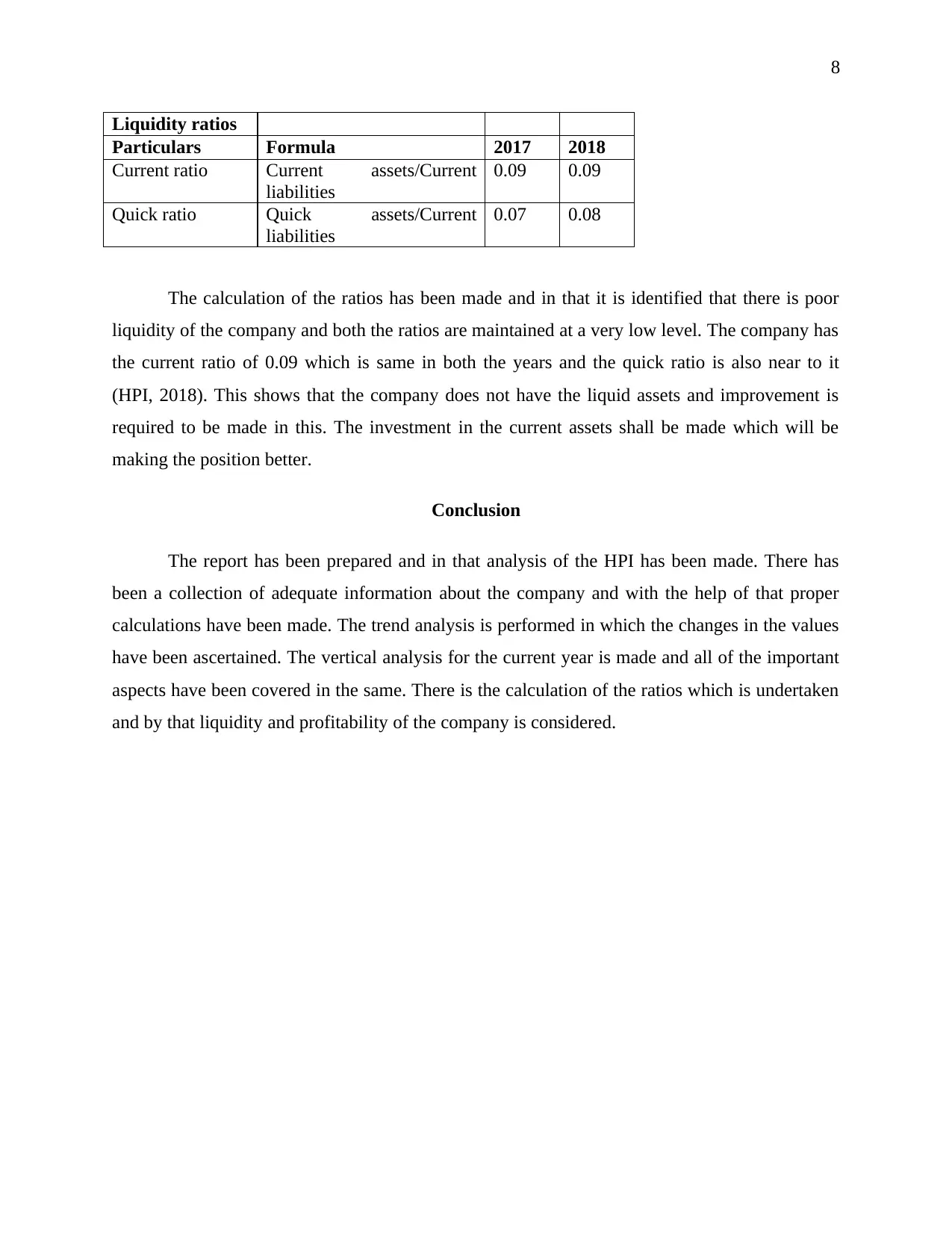
8
Liquidity ratios
Particulars Formula 2017 2018
Current ratio Current assets/Current
liabilities
0.09 0.09
Quick ratio Quick assets/Current
liabilities
0.07 0.08
The calculation of the ratios has been made and in that it is identified that there is poor
liquidity of the company and both the ratios are maintained at a very low level. The company has
the current ratio of 0.09 which is same in both the years and the quick ratio is also near to it
(HPI, 2018). This shows that the company does not have the liquid assets and improvement is
required to be made in this. The investment in the current assets shall be made which will be
making the position better.
Conclusion
The report has been prepared and in that analysis of the HPI has been made. There has
been a collection of adequate information about the company and with the help of that proper
calculations have been made. The trend analysis is performed in which the changes in the values
have been ascertained. The vertical analysis for the current year is made and all of the important
aspects have been covered in the same. There is the calculation of the ratios which is undertaken
and by that liquidity and profitability of the company is considered.
Liquidity ratios
Particulars Formula 2017 2018
Current ratio Current assets/Current
liabilities
0.09 0.09
Quick ratio Quick assets/Current
liabilities
0.07 0.08
The calculation of the ratios has been made and in that it is identified that there is poor
liquidity of the company and both the ratios are maintained at a very low level. The company has
the current ratio of 0.09 which is same in both the years and the quick ratio is also near to it
(HPI, 2018). This shows that the company does not have the liquid assets and improvement is
required to be made in this. The investment in the current assets shall be made which will be
making the position better.
Conclusion
The report has been prepared and in that analysis of the HPI has been made. There has
been a collection of adequate information about the company and with the help of that proper
calculations have been made. The trend analysis is performed in which the changes in the values
have been ascertained. The vertical analysis for the current year is made and all of the important
aspects have been covered in the same. There is the calculation of the ratios which is undertaken
and by that liquidity and profitability of the company is considered.
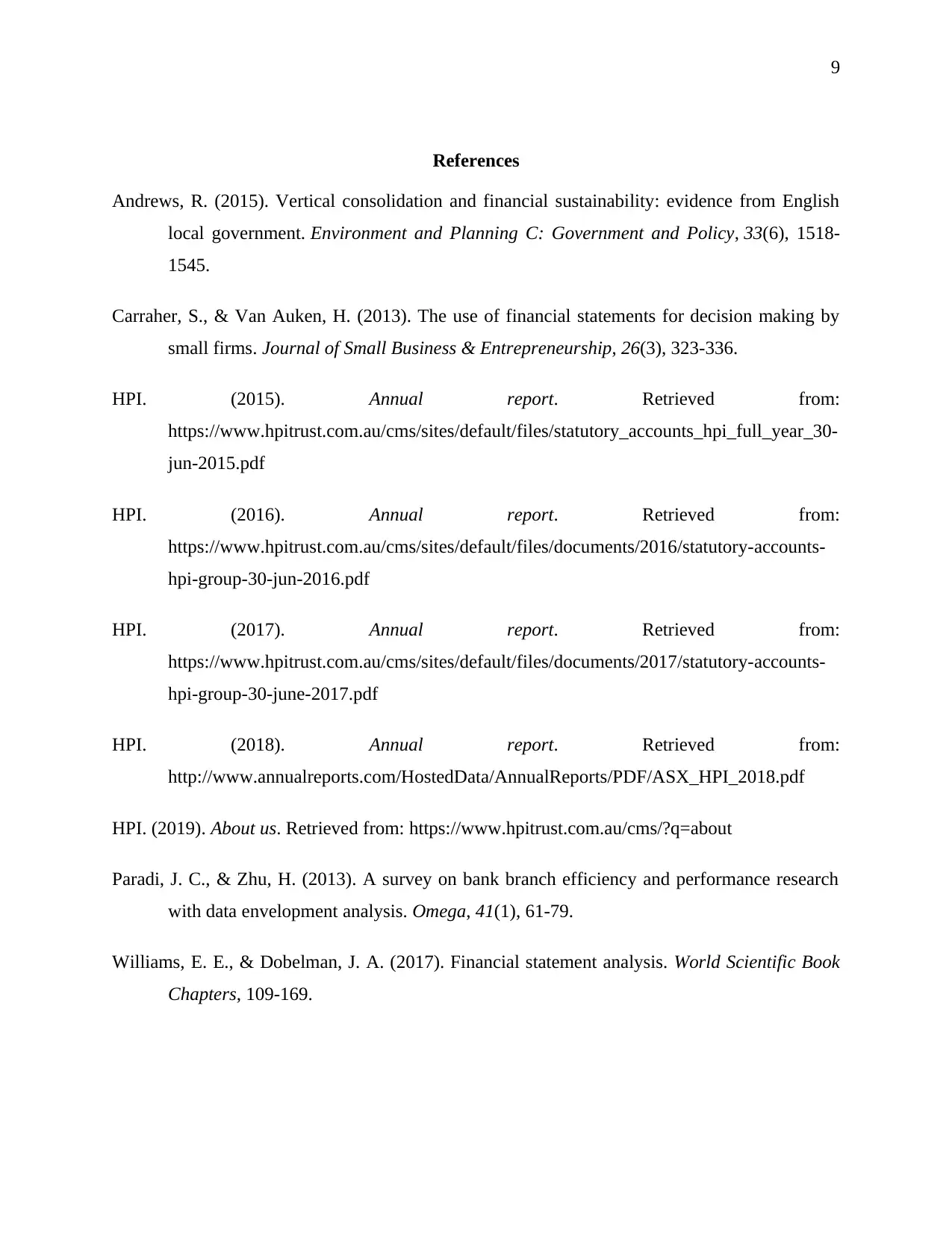
9
References
Andrews, R. (2015). Vertical consolidation and financial sustainability: evidence from English
local government. Environment and Planning C: Government and Policy, 33(6), 1518-
1545.
Carraher, S., & Van Auken, H. (2013). The use of financial statements for decision making by
small firms. Journal of Small Business & Entrepreneurship, 26(3), 323-336.
HPI. (2015). Annual report. Retrieved from:
https://www.hpitrust.com.au/cms/sites/default/files/statutory_accounts_hpi_full_year_30-
jun-2015.pdf
HPI. (2016). Annual report. Retrieved from:
https://www.hpitrust.com.au/cms/sites/default/files/documents/2016/statutory-accounts-
hpi-group-30-jun-2016.pdf
HPI. (2017). Annual report. Retrieved from:
https://www.hpitrust.com.au/cms/sites/default/files/documents/2017/statutory-accounts-
hpi-group-30-june-2017.pdf
HPI. (2018). Annual report. Retrieved from:
http://www.annualreports.com/HostedData/AnnualReports/PDF/ASX_HPI_2018.pdf
HPI. (2019). About us. Retrieved from: https://www.hpitrust.com.au/cms/?q=about
Paradi, J. C., & Zhu, H. (2013). A survey on bank branch efficiency and performance research
with data envelopment analysis. Omega, 41(1), 61-79.
Williams, E. E., & Dobelman, J. A. (2017). Financial statement analysis. World Scientific Book
Chapters, 109-169.
References
Andrews, R. (2015). Vertical consolidation and financial sustainability: evidence from English
local government. Environment and Planning C: Government and Policy, 33(6), 1518-
1545.
Carraher, S., & Van Auken, H. (2013). The use of financial statements for decision making by
small firms. Journal of Small Business & Entrepreneurship, 26(3), 323-336.
HPI. (2015). Annual report. Retrieved from:
https://www.hpitrust.com.au/cms/sites/default/files/statutory_accounts_hpi_full_year_30-
jun-2015.pdf
HPI. (2016). Annual report. Retrieved from:
https://www.hpitrust.com.au/cms/sites/default/files/documents/2016/statutory-accounts-
hpi-group-30-jun-2016.pdf
HPI. (2017). Annual report. Retrieved from:
https://www.hpitrust.com.au/cms/sites/default/files/documents/2017/statutory-accounts-
hpi-group-30-june-2017.pdf
HPI. (2018). Annual report. Retrieved from:
http://www.annualreports.com/HostedData/AnnualReports/PDF/ASX_HPI_2018.pdf
HPI. (2019). About us. Retrieved from: https://www.hpitrust.com.au/cms/?q=about
Paradi, J. C., & Zhu, H. (2013). A survey on bank branch efficiency and performance research
with data envelopment analysis. Omega, 41(1), 61-79.
Williams, E. E., & Dobelman, J. A. (2017). Financial statement analysis. World Scientific Book
Chapters, 109-169.
⊘ This is a preview!⊘
Do you want full access?
Subscribe today to unlock all pages.

Trusted by 1+ million students worldwide
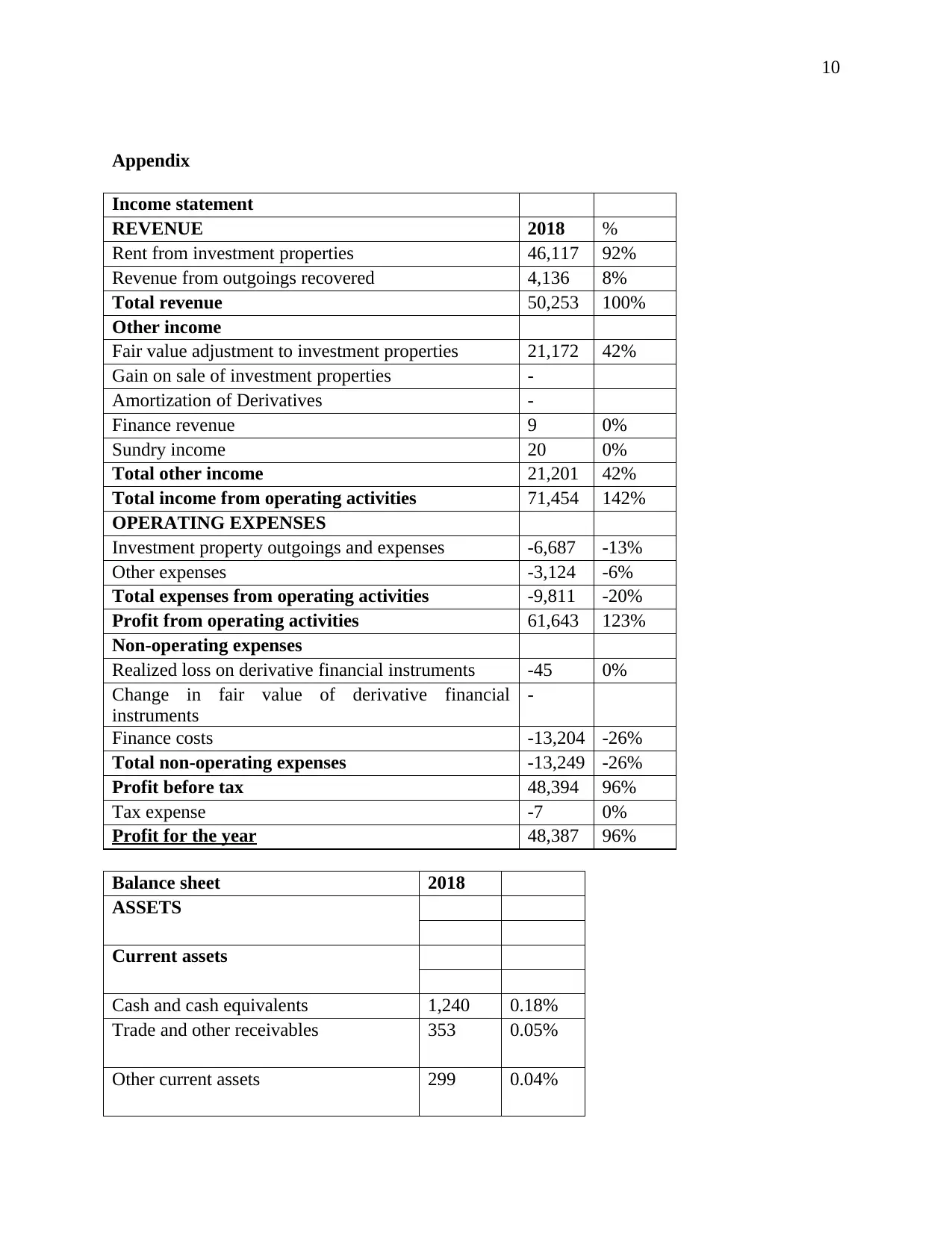
10
Appendix
Income statement
REVENUE 2018 %
Rent from investment properties 46,117 92%
Revenue from outgoings recovered 4,136 8%
Total revenue 50,253 100%
Other income
Fair value adjustment to investment properties 21,172 42%
Gain on sale of investment properties -
Amortization of Derivatives -
Finance revenue 9 0%
Sundry income 20 0%
Total other income 21,201 42%
Total income from operating activities 71,454 142%
OPERATING EXPENSES
Investment property outgoings and expenses -6,687 -13%
Other expenses -3,124 -6%
Total expenses from operating activities -9,811 -20%
Profit from operating activities 61,643 123%
Non-operating expenses
Realized loss on derivative financial instruments -45 0%
Change in fair value of derivative financial
instruments
-
Finance costs -13,204 -26%
Total non-operating expenses -13,249 -26%
Profit before tax 48,394 96%
Tax expense -7 0%
Profit for the year 48,387 96%
Balance sheet 2018
ASSETS
Current assets
Cash and cash equivalents 1,240 0.18%
Trade and other receivables 353 0.05%
Other current assets 299 0.04%
Appendix
Income statement
REVENUE 2018 %
Rent from investment properties 46,117 92%
Revenue from outgoings recovered 4,136 8%
Total revenue 50,253 100%
Other income
Fair value adjustment to investment properties 21,172 42%
Gain on sale of investment properties -
Amortization of Derivatives -
Finance revenue 9 0%
Sundry income 20 0%
Total other income 21,201 42%
Total income from operating activities 71,454 142%
OPERATING EXPENSES
Investment property outgoings and expenses -6,687 -13%
Other expenses -3,124 -6%
Total expenses from operating activities -9,811 -20%
Profit from operating activities 61,643 123%
Non-operating expenses
Realized loss on derivative financial instruments -45 0%
Change in fair value of derivative financial
instruments
-
Finance costs -13,204 -26%
Total non-operating expenses -13,249 -26%
Profit before tax 48,394 96%
Tax expense -7 0%
Profit for the year 48,387 96%
Balance sheet 2018
ASSETS
Current assets
Cash and cash equivalents 1,240 0.18%
Trade and other receivables 353 0.05%
Other current assets 299 0.04%
Paraphrase This Document
Need a fresh take? Get an instant paraphrase of this document with our AI Paraphraser
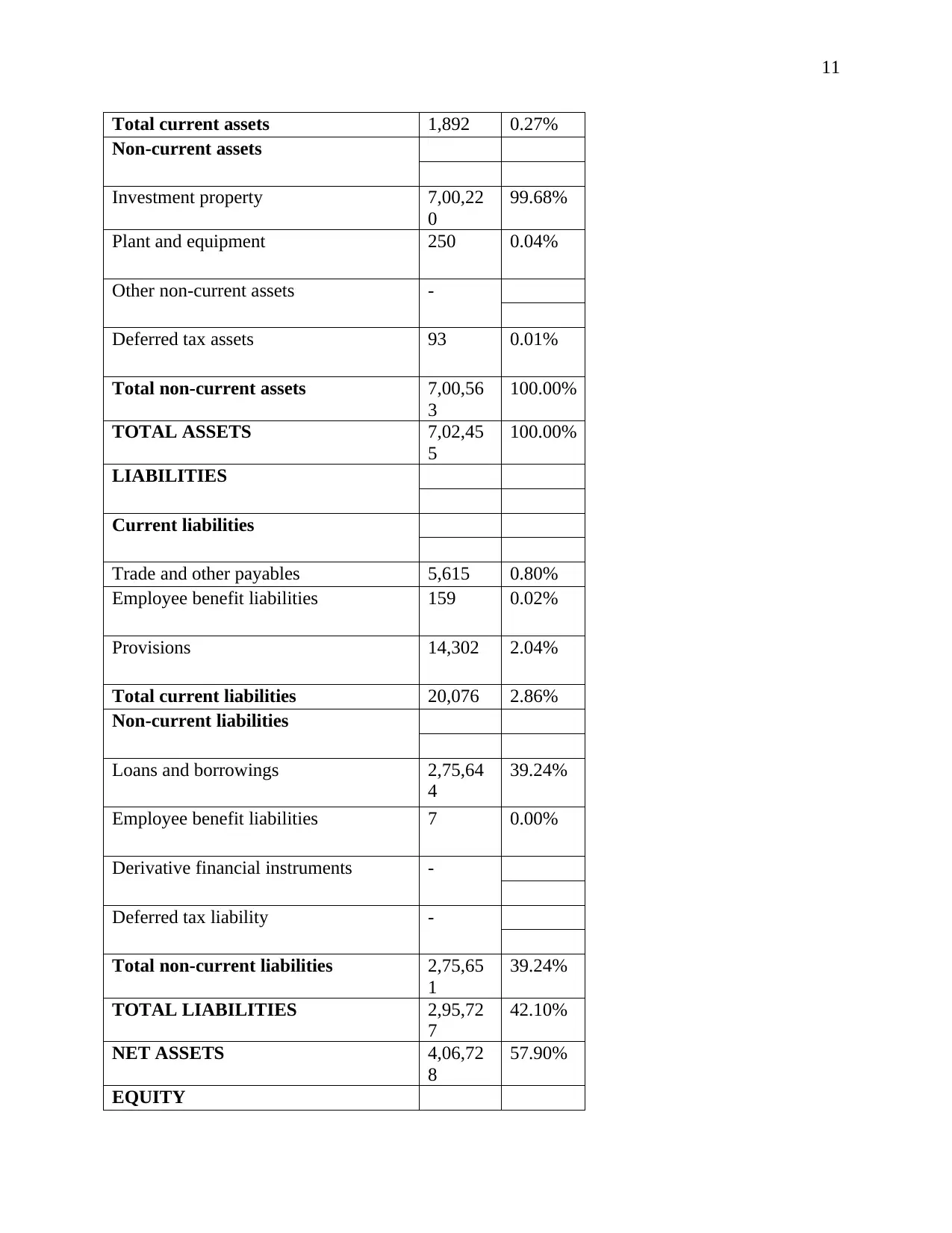
11
Total current assets 1,892 0.27%
Non-current assets
Investment property 7,00,22
0
99.68%
Plant and equipment 250 0.04%
Other non-current assets -
Deferred tax assets 93 0.01%
Total non-current assets 7,00,56
3
100.00%
TOTAL ASSETS 7,02,45
5
100.00%
LIABILITIES
Current liabilities
Trade and other payables 5,615 0.80%
Employee benefit liabilities 159 0.02%
Provisions 14,302 2.04%
Total current liabilities 20,076 2.86%
Non-current liabilities
Loans and borrowings 2,75,64
4
39.24%
Employee benefit liabilities 7 0.00%
Derivative financial instruments -
Deferred tax liability -
Total non-current liabilities 2,75,65
1
39.24%
TOTAL LIABILITIES 2,95,72
7
42.10%
NET ASSETS 4,06,72
8
57.90%
EQUITY
Total current assets 1,892 0.27%
Non-current assets
Investment property 7,00,22
0
99.68%
Plant and equipment 250 0.04%
Other non-current assets -
Deferred tax assets 93 0.01%
Total non-current assets 7,00,56
3
100.00%
TOTAL ASSETS 7,02,45
5
100.00%
LIABILITIES
Current liabilities
Trade and other payables 5,615 0.80%
Employee benefit liabilities 159 0.02%
Provisions 14,302 2.04%
Total current liabilities 20,076 2.86%
Non-current liabilities
Loans and borrowings 2,75,64
4
39.24%
Employee benefit liabilities 7 0.00%
Derivative financial instruments -
Deferred tax liability -
Total non-current liabilities 2,75,65
1
39.24%
TOTAL LIABILITIES 2,95,72
7
42.10%
NET ASSETS 4,06,72
8
57.90%
EQUITY
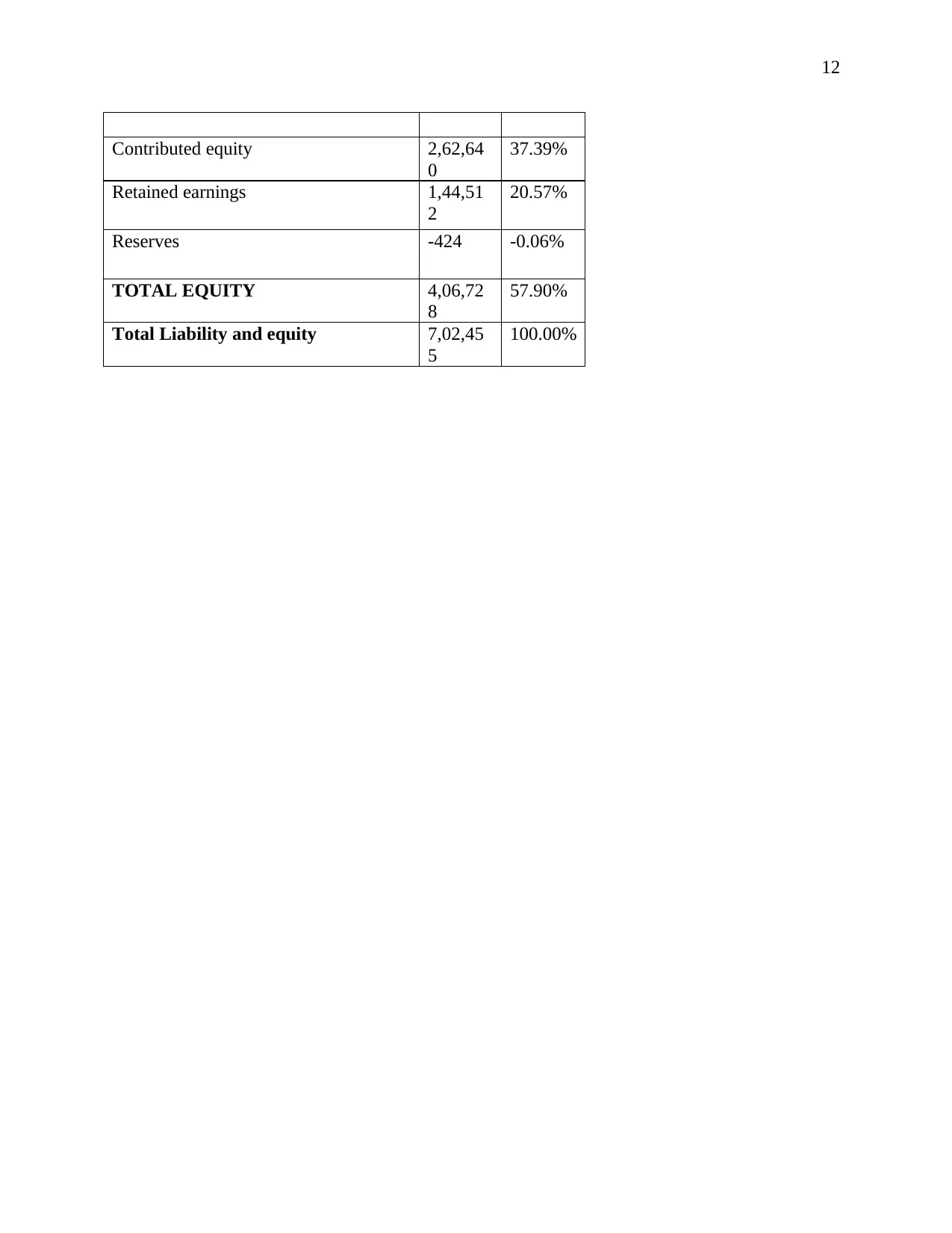
12
Contributed equity 2,62,64
0
37.39%
Retained earnings 1,44,51
2
20.57%
Reserves -424 -0.06%
TOTAL EQUITY 4,06,72
8
57.90%
Total Liability and equity 7,02,45
5
100.00%
Contributed equity 2,62,64
0
37.39%
Retained earnings 1,44,51
2
20.57%
Reserves -424 -0.06%
TOTAL EQUITY 4,06,72
8
57.90%
Total Liability and equity 7,02,45
5
100.00%
⊘ This is a preview!⊘
Do you want full access?
Subscribe today to unlock all pages.

Trusted by 1+ million students worldwide
1 out of 12
Related Documents
Your All-in-One AI-Powered Toolkit for Academic Success.
+13062052269
info@desklib.com
Available 24*7 on WhatsApp / Email
![[object Object]](/_next/static/media/star-bottom.7253800d.svg)
Unlock your academic potential
Copyright © 2020–2025 A2Z Services. All Rights Reserved. Developed and managed by ZUCOL.





